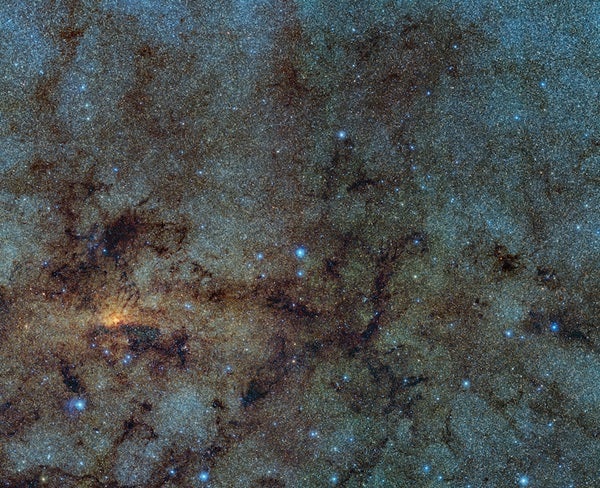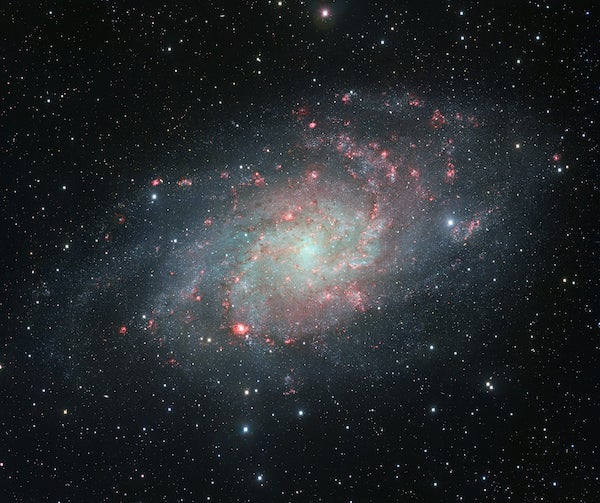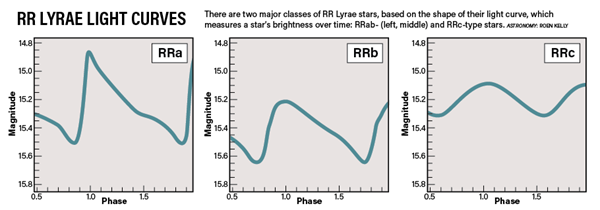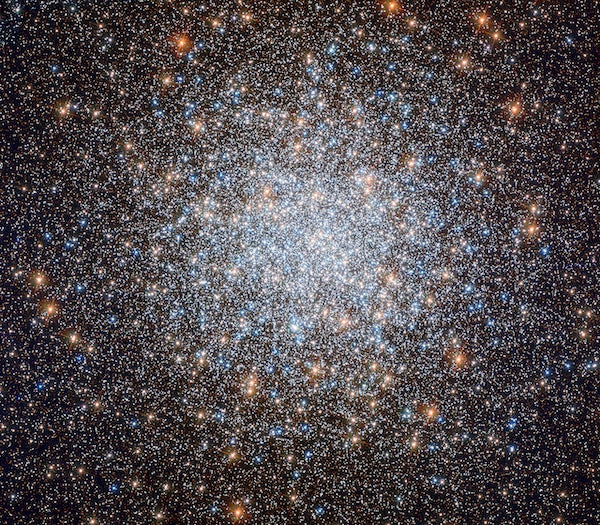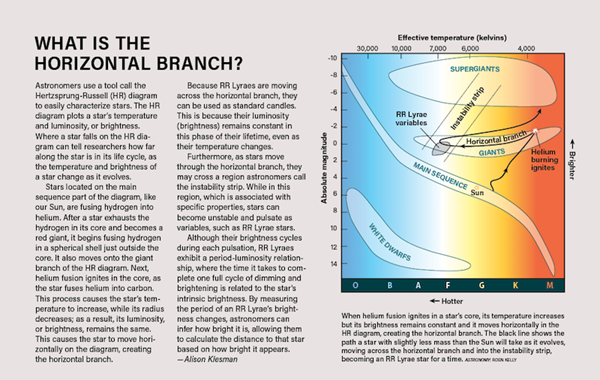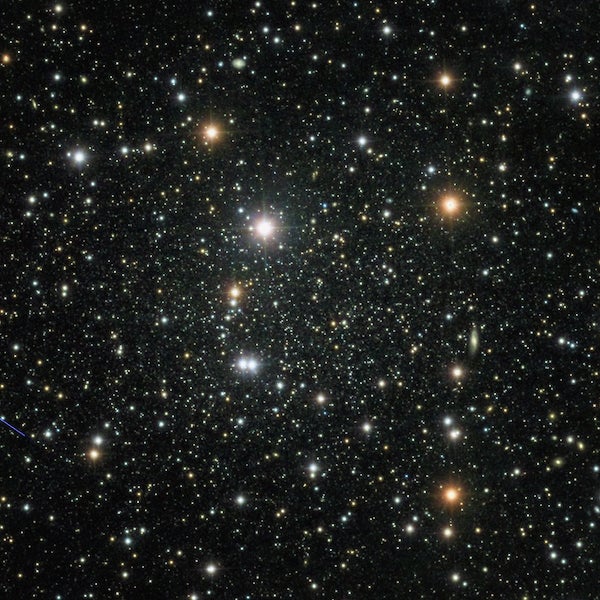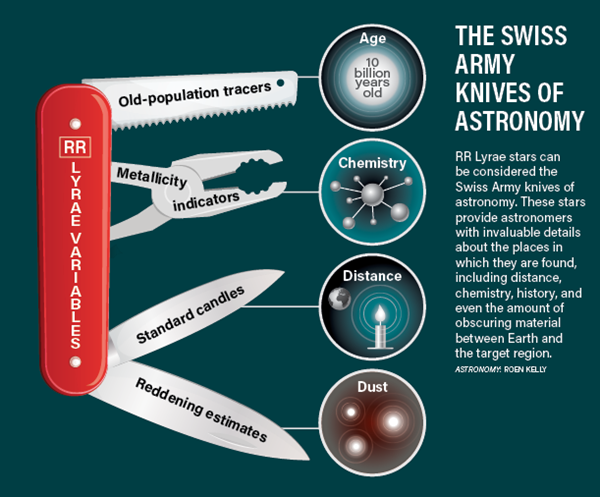Our star is stable because the balance between the inward force of gravity and the outward force exerted by the hot gas in its interior allows it to maintain a constant radius and thus a constant luminosity. But this will not always be the case. The Sun is a typical main sequence star fusing hydrogen into helium in its core. In about 5 billion years, when it runs out of hydrogen in its core, the Sun will evolve into a red giant, and soon after, it will enter the “horizontal branch” chapter of its life. In this phase, it will shine by combining three helium nuclei to produce one carbon nucleus at temperatures of 100 million kelvins in its central regions.
During its life in the horizontal branch phase, the Sun may experience an imbalance between the outward flow of energy and the force of gravity trying to hold it together. When this happens, our star will become unstable and begin to pulsate, its radius increasing and decreasing by as much as 20 percent over a period between 12 and 24 hours. As it experiences this change, the Sun’s light will vary by as much as four times between its faintest and brightest points. It will become a type of variable known as an RR Lyrae star.
RR Lyrae stars
Named after the prototype of the group — RR Lyrae, a variable star in the constellation Lyra the Harp — these pulsating variables are common in the night sky and are favorite targets of amateur astronomers such as those in the American Association of Variable Star Observers. RR Lyraes are important to professional astronomers as well, because they serve as the lynchpin for galactic structure studies, revealing important clues about the regions in which they are found.
RR Lyrae stars are grouped into two classes based on the shapes of their light curves. A light curve shows the change in the star’s brightness over time and measures the period, amplitude, and shape of the variation. The period is how long it takes the RR Lyrae to undergo one complete cycle, and the amplitude is the amount of brightening that the star exhibits. RRab variables are the most common and exhibit sawtooth-shaped light curves, while RRc variables have shorter periods and roughly sinusoidal light curves. The RRab-type variables can help astronomers decipher many of the properties of galaxies and, as such, researchers such as myself refer to them as the Swiss Army knives of astronomy.
What RR Lyraes reveal
The most basic property of a stellar population, such as a star cluster or a galaxy, is its distance. RR Lyrae variables are standard candles — objects for which their intrinsic brightness is known, so that a comparison with their observed apparent brightness allows astronomers to calculate their distance. Thus, these stars can be used to map out the regions of our galaxy in which they reside.
Another important property of stellar populations is age, or how long ago the stars in a galaxy or star cluster formed. RR Lyrae variables “shine” here as well. In order to become an RR Lyrae variable, a star must evolve beyond the main sequence and onto the horizontal branch. Thus, these stars are advanced in age. As it turns out, only stars older than about 10 billion years can become RR Lyrae variables. If we find such a star in a particular galaxy or globular cluster, then that object must be at least 10 billion years old. Since the universe is about 13.8 billion years old, this implies that the globular clusters and galaxies that contain RR Lyrae variables were formed relatively soon after the Big Bang that created the universe itself.
Along with their distances and ages, globular clusters and galaxies are also characterized by the metal content of their stars. (In astronomy, “metals” are all elements heavier than helium.) The Big Bang produced mostly hydrogen and helium, along with a negligible fraction of metals. The vast majority of metals in the universe today — and, thus, all of the elements that make up the everyday objects we encounter on Earth — were synthesized in stars. Each generation of stars produces metals; upon reaching the end of its life, each star distributes those metals through the interstellar medium, where the enriched gas is used as raw material to make more stars. As a result, each successive generation of stars has more metals than the previous generation. This is known as chemical enrichment.
The chemical enrichment history of a stellar population is related to its age, but not always in an expected and predictable manner. For example, one of the most perplexing aspects of open star clusters in the Milky Way is that there is no apparent correlation between their ages and metal abundances. This means younger open clusters don’t necessarily have more metals than older ones. The reason for this is not immediately clear. Nevertheless, the metal abundance of a star cluster or galaxy is an important clue that helps us to piece together its formation and evolutionary chronology.
RR Lyrae variables are also a powerful tool for measuring the metal content of stellar populations. As it turns out, the periods and amplitudes of these stars can be used to determine their metal abundances, and thus infer the metal content of their host stellar systems. In general, the shorter the period of an RR Lyrae variable, the more metal-rich it is. Given that a stellar population must be ancient to produce an RR Lyrae star, it stands to reason that most, if not all, RR Lyraes are relatively deficient in metals. That is to say, their progenitors were formed early in the history of the universe when the overall metal content of galaxies was comparatively low. However, metal-rich RR Lyrae variables — as metal-rich as the Sun — are not uncommon in the Milky Way, presenting an especially puzzling scenario to researchers working to understand their origins.
Lifting the veil
I want to highlight one more way in which these stars help astronomers better understand the universe. To appreciate this aspect of RR Lyrae stars, it is important to realize that the dust in interstellar space acts like an absorbing curtain that limits our ability to study certain parts of the galaxy and in some directions of the sky. This dust makes background starlight fainter and redder. We use the term extinction to refer to the former and reddening for the latter. Researchers also call reddening “color excess”; it is calculated by comparing the observed color of an object (through dust) to its intrinsic color in the absence of dust. Dust extinction and reddening are often the most challenging obstacles to our ability to study objects in the galaxy and located outside of it.
Here, too, RR Lyrae variables show their promise by providing a means by which to measure the amount of extinction and reddening along the line of sight. Observations of nearby ab-type RR Lyrae variables — the ones with the sawtooth-shaped light curves — that present zero or negligible reddening show they all have the same color at the faintest part of their light curve, also known as minimum light. Therefore, the intrinsic minimum-light color of these variable stars is constant regardless of their other properties. This means that we can compare the observed minimum-light color of an ab-type variable to what we know it should be in the absence of dust and calculate the amount of reddening along the line of sight to the RR Lyrae. From that knowledge, we therefore get the amount reddening to the star cluster or galaxy that hosts the star.
Beyond the Milky Way
Not only are RR Lyrae variables the Swiss Army knives of astronomy in galactic studies, they are also applicable to extragalactic environments. With the high-resolution imaging capabilities of the Hubble Space Telescope (HST), it is routinely possible to identify and characterize RR Lyrae stars in galaxies well beyond the Milky Way. A good example that illustrates the broad applicability of RR Lyrae variables is my own work using HST observations of these stars in the nearby late-type spiral galaxy M33, also known as the great spiral galaxy in Triangulum. This system is located at a distance of 2.8 million light-years and we think it is a satellite of the Andromeda Galaxy (M31), which is 2.5 million light-years distant.
M33 is seen nearly face-on in the sky. Prior to HST, ground-based observations using the Palomar 5.1-meter telescope and early-generation CCD detectors in 1985 were able to show that M33 contains RR Lyrae stars, but had a difficult time measuring their properties such as their periods and amplitudes of variation. HST’s superior high-resolution imaging capabilities have allowed us to not only identify these stars in M33, but also to precisely measure their properties.
The discovery of RR Lyrae stars in M33 yielded the first evidence that this galaxy contains a population as old as the ones in the Milky Way and Andromeda. As described above, the fact that RR Lyrae variables are in the horizontal branch phase of evolution means that they are older than about 10 billion years. Therefore, soon after the Big Bang, all three of the spiral galaxies in our local galactic neighborhood began forming stars at about the same time, within 1 billion years of one another.
The observations of M33 also show that its RR Lyrae stars fall into two distinct reddening regimes. One set exhibits low reddening consistent with being affected solely by dust in the Milky Way Galaxy. The other set is fainter and redder, apparently affected by an additional source of reddening and extinction. At first, the presence of an additional layer of dust in the direction of these RR Lyrae stars presents an intriguing puzzle. But a glance at M33 itself reveals the possibility that we may be viewing these stars through the spiral arms of M33 and on the other side of the galaxy. The stars with low reddening are located on the near side of M33, while those with high reddening are on the far side. Yet, besides their reddening, all of their other properties, such as period, amplitude, and metal abundance, are similar. This is the first time we have isolated stellar populations in distinct line-of-sight components in a galaxy that is so far away.
The future of RR Lyraes
RR Lyrae stars have taught us much about our galaxy and even those nearby, but their contribution to astronomy is far from complete. Currently under construction in the Chilean Andes, the 8.4-meter Simonyi Survey Telescope at the Vera C. Rubin Observatory (formerly called the Large Synoptic Survey Telescope) will map the entire southern sky every few nights. As it does, the telescope will observe close to 1 million RR Lyrae stars in the Milky Way.
These RR Lyrae stars and the information on age, metal abundance, and reddening that they yield will revolutionize the field of galactic archeology. This field endeavors to understand the structure, formation, and evolution of the Milky Way — our galactic home. And the distances inferred for every single one of these stars will provide a structural map of the Milky Way, allowing us to visualize it in three dimensions.
With the power of the Rubin Observatory, particularly over time, the reach of new RR Lyrae research will also extend out into the Local Group. The growing pool of RR Lyrae stars will allow astronomers to bring to bear this versatile tool on our efforts to better understand the formation and evolution of our larger galactic neighborhood.

